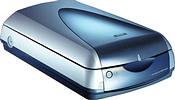Epson unveils Perfection 4870 Photo
1 August 2004

Epson's Perfection 4870 Photo scanner brings groundbreaking Digital Ice Technology to the graphics or photography professional.
The Perfection 4870 Photo has an optical resolution of 4800 x 9600 dpi - the highest in its class - which allows a 35 mm piece of film to be enlarged to 60 cm x 80 cm (A1). By coupling this vast resolution with a moving TPU (transparency unit) lamp, Epson's newest flatbed scanner is competitive in quality as well as price.
The inclusion of the Digital Ice Technology allows for film and prints to be scanned for reprinting, archiving, enlargement and picture restoration, without compromising on quality.
The Perfection 4870 Photo is so powerful that the grain of the film can be detected when scanning at high resolutions. Available in the Professional Mode, Grain Reduction acts as a multilevel diffuser that blends the grain allowing you to scan small areas for enlargement. Sometimes the grain is desired, so the user is left with the final artistic decision to use it or not.
The Digital Ice Technology automatically removes surface defects such as dust and scratches from a scanned image. Digital Ice Technology differentiates itself from software-only solutions because it does not soften, blur or otherwise alter any underlying details or composition of the original image. Instead, the patented technology works from within the scanner during the scanning process to provide the user with a clear, authentic base image that improves the original image. The user does not need to learn or install any additional software to make the Digital Ice Technology work.
The Digital Ice Photo Print Technology within the Perfection 4870 Photo works by utilising two light sources, reflecting on the image from different directions. Digital Ice Photo Print Technology uses a defect map to identify the precise locations of physical defects, or visual 'noise' on a print being scanned. Differential shadowing technology and proprietary software algorithms quickly and automatically eliminate the unwanted defects, producing a scanned image file that improves upon the original print.
Digital Ice Photo Print Technology is designed to remove dust and lint, while also correcting scratches, cracks, rips, and creases found on the surface of most prints.
"Before the Perfection 4870 Photo, users wanting professional quality photo restoration really had only one option - expensive film scanners. The Perfection 4870 Photo breaks the mould with its innovative blending of film scanner features and flatbed flexibility," says Hans Dummer, country manager, Epson SA.
To cater for every professional's needs, the Perfection 4870 Photo has optical density of 3.8DMax, which enables the scanner to detect the data often lost by scanners in extreme highlight and shadow areas. The 3.8DMax figure is actual, not a mathematical theory, and will allow the professional photographer to get the most from their images.
The scanner's powerful USB 2.0 Hi-Speed and IEEE-1394 FireWire interfaces produce fast and accurate scans. The professional-level SilverFast SE6 scanning and imaging software add a whole host of graphical benefits such as selective colour correction and NegaFix negative film optimiser; and Epson's Colour Restoration system and Adobe Photoshop Elements 2.0 complete the Perfection 4870 Photo package.
For more information contact Belinda Wilson, Epson, 011 465 9621, bwilson@epson.co.za
Others who read this also read these articles
Seven factors to consider when investing in a colour printer/copier
Proposals, presentations, even internal reports are being created and reproduced in colour to communicate messages more persuasively and with greater impact[ August 2002 ]
More than 70 years experience in engineering documentation
"Océ has built up a leading position on its markets worldwide by supplying products and services that are characterised by their high quality, reliability, productivity, durability, ease-of-use and environmental friendliness."[ August 2001 ]
MacDermid ColorSpan announces a new 12-head high-speed printer
"This printer is perfect for any company that needs high volume poster printing, because of its speed," says Ken Bezuidenhout, Managing Director of Protea Graphics.[ August 2001 ]
Océ provides solutions at EMS
The solutions will also assist EMS in achieving their primary business objective, ie concentrating on the core business of project management and thereby allow Océ to improve the efficiency and workflow of document reproduction[ April 2001 ]
When seeing is believing
The company's visual systems support the full range of commercial aircraft and are compatible with systems from all major flight simulator manufacturers[ Feb 2000 ]
Protea Graphics announces new wide inkjet printer
DisplayMaker Esprit is positioned to be the best value printer in its price class[ December 2000 ]
Printers receive positive feedback
Encad's channel partners have also reported high productivity and reliability for the NJ500 and NJ700 printing solutions, which were introduced along with the NovaJet 630 (NJ 630).[ June/July 2000 ]
Océ 8399 breaks price barrier ... for in-house, wide-format laser printing
With the Océ 9300, the quality and productivity of Océ LED printing is now available to users in medium and large engineering workgroups[ April/May 2000 ]
Others who read this also read these news items
Return of a classic
[ December 2005 ]
LAW Printing goes A1
[ December 2005 ]
White ink and clear varnish enhance images
[ December 2005 ]
New A0 colour scanner
[ December 2005 ]
UV curable inkjet printer
[ December 2005 ]
EFI Designer Edition - delivers quality projects
[ December 2005 ]
Wide format printing conquers the world
[ October 2005 ]
New generation of large-format inkjet printers
[ October 2005 ]
Search Site
Subscribe
Previous Issues
Other Technews Publications
Other Technews Buyers Guides
 |  | Copyright c1995-2009 Technews Publishing (Pty) Ltd.. All rights reserved. |